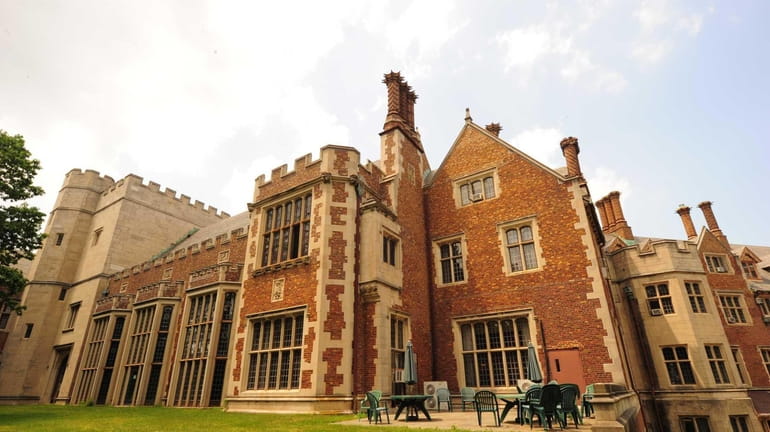7 LI historic sites listed as threatened

St. Ignatius Jesuit Retreat House is one of seven historic Long Island sites deemed endangered. (June 10, 2011) Credit: Newsday / Alejandra Villa
The 1750 La Grange Inn in West Islip and the 1899 Oyster Bay railroad station are among seven historic sites that Long Island's most prominent preservation group has listed as threatened by development or neglect.
The properties, nominated by other groups or individuals, are on the Society for the Preservation of Long Island Antiquities' third Endangered Historic Places List, a project the organization began in 2010.
"The point of the list is to shine a light on properties that are endangered for varying reasons from outright demolition to insensitive maintenance," said Alexandra Wolfe, SPLIA's preservation services director. "It's a call for action and a tool for education to encourage local organizations, individuals and communities to start identifying what matters to them and become part of the solution."
SPLIA said the properties "exemplify the vast diversity and character of Long Island's historic resources."
Besides the inn named for the estate of the Marquis de La Fayette, the French Revolutionary War general who visited in 1824, and the Oyster Bay depot used by President Theodore Roosevelt, the list includes: an Art Deco bank in Freeport; the St. Ignatius Retreat House at Inisfada in Manhasset; a cluster of historic buildings that are part of the last vestige of historic Jericho; a late 19th century Cutchogue church; and an 18th century Southampton ship captain's house.
Here are the details:
The La Grange Inn, which most recently was a restaurant-catering facility and has undergone several expansions, has been vacant since 2010. The owner is negotiating with CVS, which wants to build a drugstore on the Montauk Highway site, about removing the additions to the inn, moving the original building elsewhere on the site and then restoring it. SPLIA said "there are concerns that the proposed solution will compromise . . . the building."
The Oyster Bay train station, listed on the National Register of Historic Places and also a town landmark, was vacated by the Long Island Rail Road in 1999 and acquired by the Town of Oyster Bay in 2004. The Oyster Bay Railroad Museum is trying to restore the building as a museum and visitor center, but SPLIA has said the project has stalled for a lack of money and community and government support.
"It's deteriorating by not being used regularly and not being restored," Wolfe said. SPLIA said there needs to be greater commitment and leadership from the town, which had no immediate comment Friday.
John Specce, railroad museum president, said, "We welcome the designation -- anything that will bring attention to the station and its need for restoration." His group, which already uses the gutted building for special events, is trying to raise $100,000 to replace windows and doors and make other exterior repairs.
The Meadow Brook Bank Building was built in 1929 on Sunrise Highway in Freeport and at the time was the tallest building east of Jamaica. SPLIA said "it played an important role in Freeport's commercial development" and is reminiscent of an Art Deco version of Manhattan's Flatiron Building. The building, whose facade features Mayan reliefs, has been empty since the 1980s. It has no landmark protection.
The St. Ignatius Retreat House at Inisfada on Searingtown Road is part of what was originally the Nicholas and Genevieve Brady estate, developed between 1916 and 1920 in East Hills. Genevieve Brady donated the estate to the Society of Jesus in 1937. Last June, the New York Province of the Society of Jesus announced the closing of the retreat and put the property up for sale. SPLIA said there is no landmark protection for the Tudor-revival main house, which is largely untouched. A rare chapel inside the house where a future pope once prayed will be saved and given to Fordham University, the Roman Catholic order said last week.
Old Cedar Swamp Road between Routes 106 and 107 in Jericho is lined with late 18th- to 19th-century buildings. The area is threatened by the proposed demolition of two buildings to construct an assisted-living facility, SPLIA said, which would alter the character of the neighborhood.
The Sacred Heart Church, rectory and carriage house were built in 1878 at 2700 Main Rd. in Cutchogue by and for Irish and German farm families. The Diocese of Rockville Centre is consolidating operations on the North Fork and the vacant church is in poor condition and is not protected by a landmark designation, SPLIA said. The Cutchogue-New Suffolk Historical Council is trying to devise a preservation strategy.
The Henry Rhodes House, built in the mid-18th century in Southampton for a ship captain, is one of only a handful of pre-Revolutionary War dwellings remaining in the village. Vacant and neglected since the 1980s, the building at 22 Windmill Lane faces demolition by its owner. It was moved to its current location in the 1920s and its exterior significantly altered for commercial use in the 1930s. "Nonetheless, much of its original interior structure and architectural detail is remarkably well preserved," SPLIA said.
Gilgo-related search continues ... Trump hush money trial latest ... Gang member stands trial ... What's up on LI
Gilgo-related search continues ... Trump hush money trial latest ... Gang member stands trial ... What's up on LI
